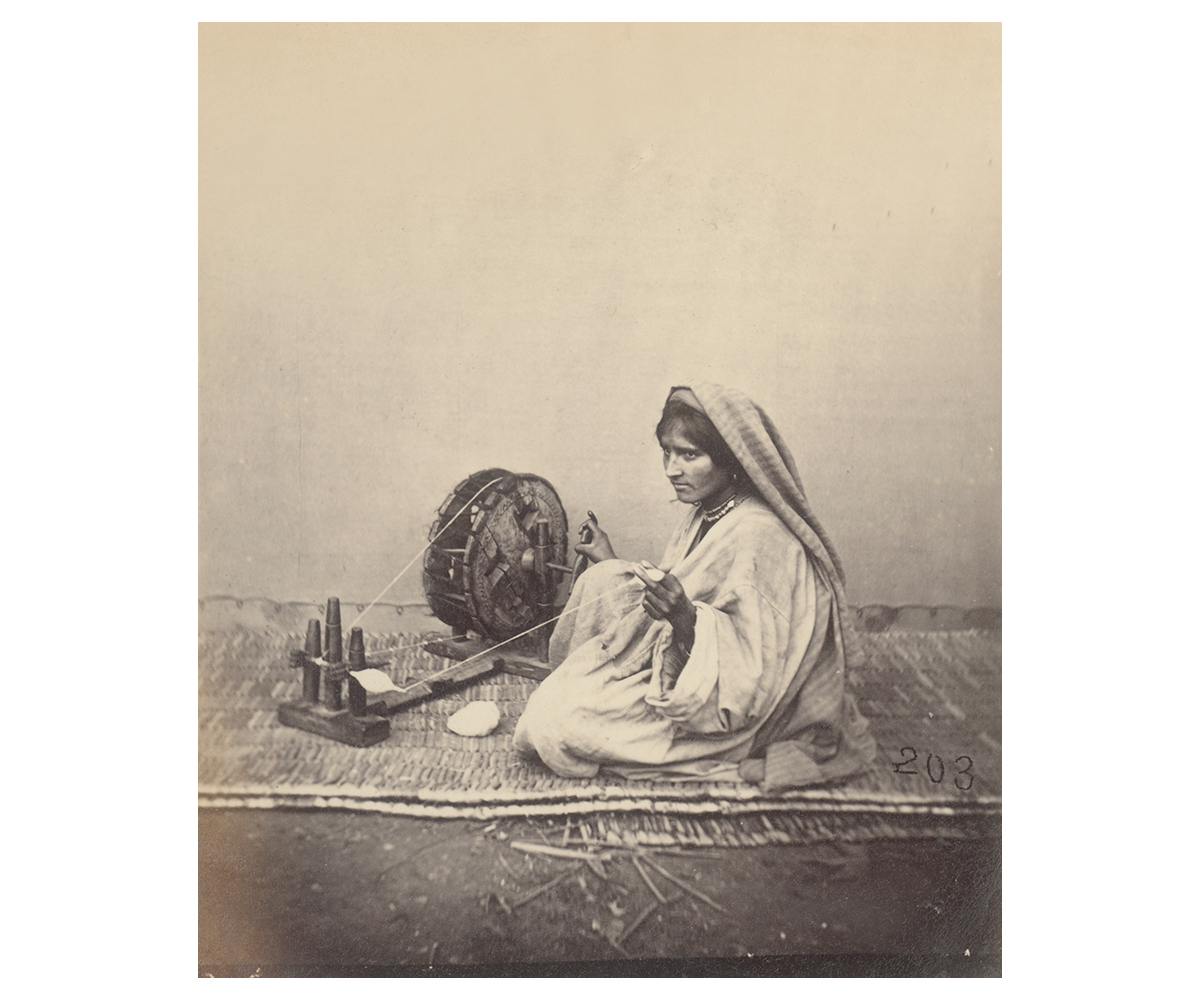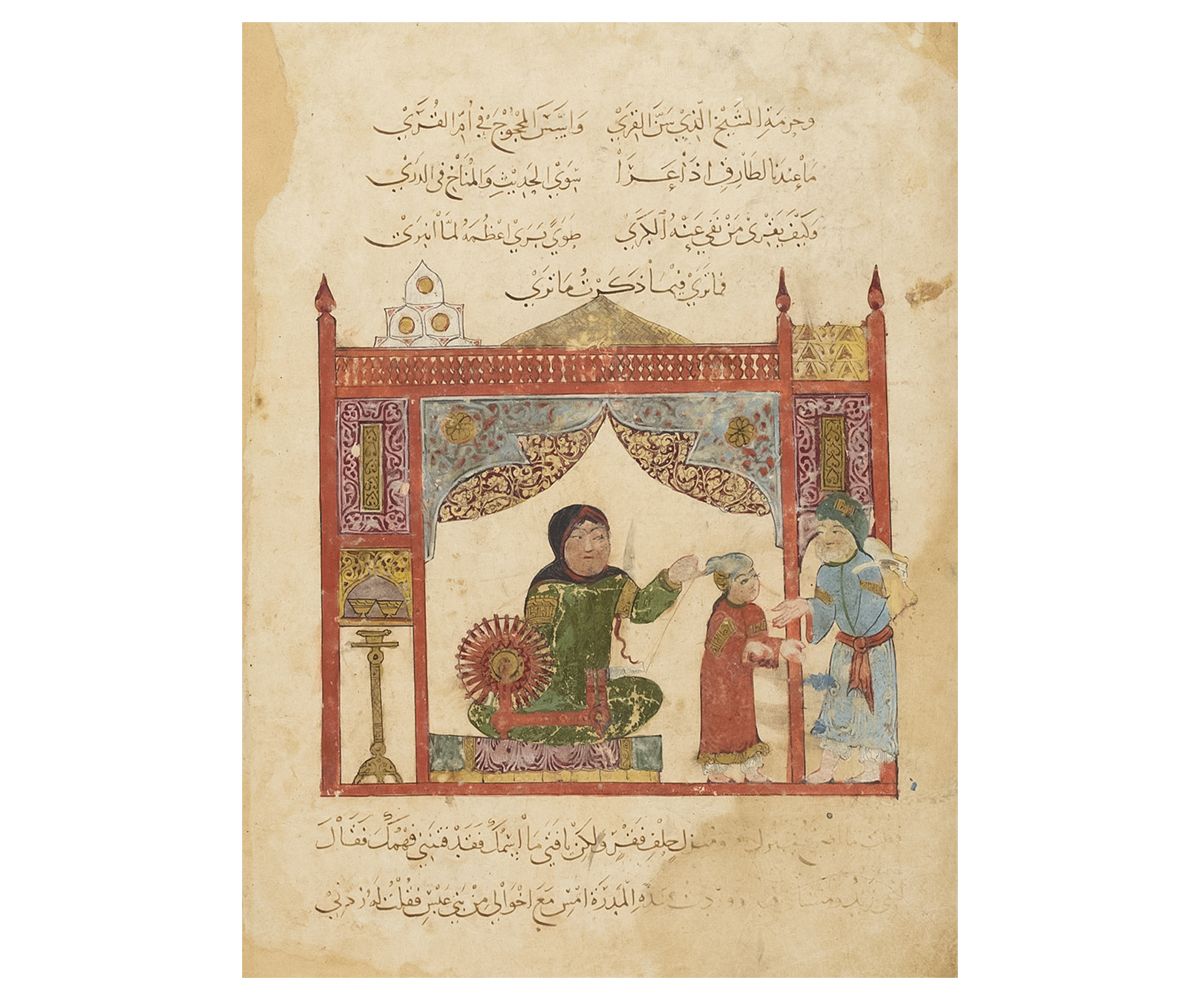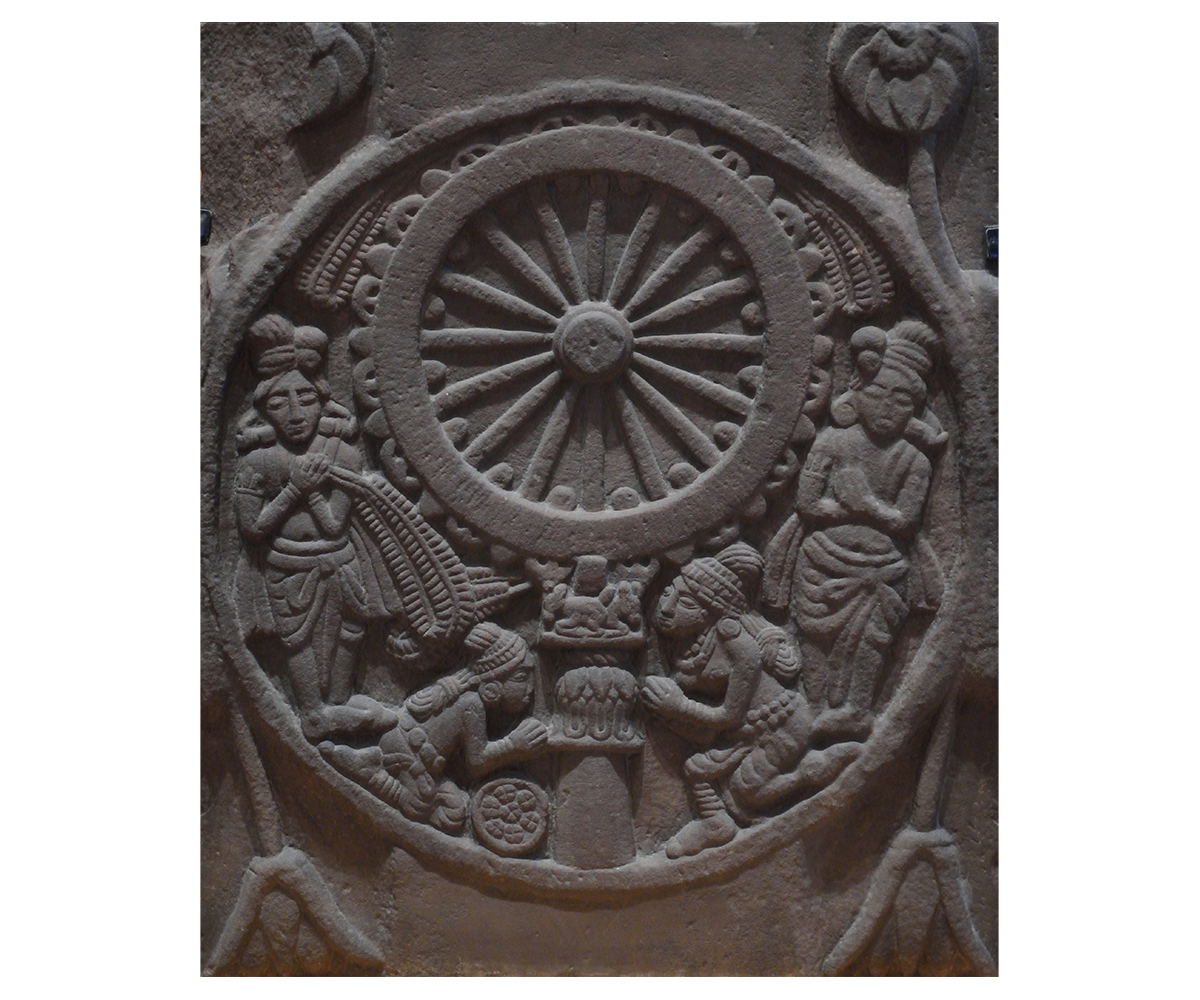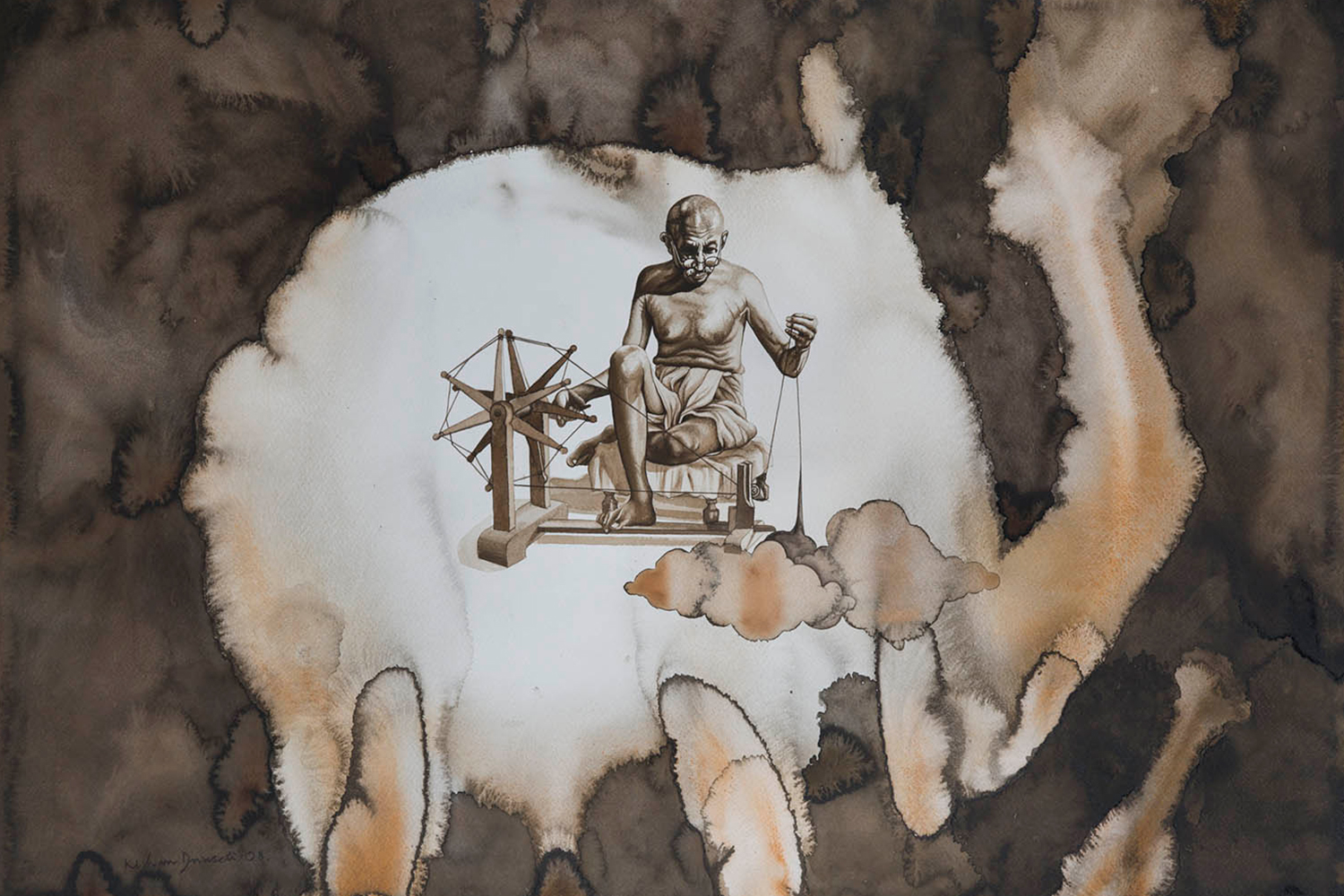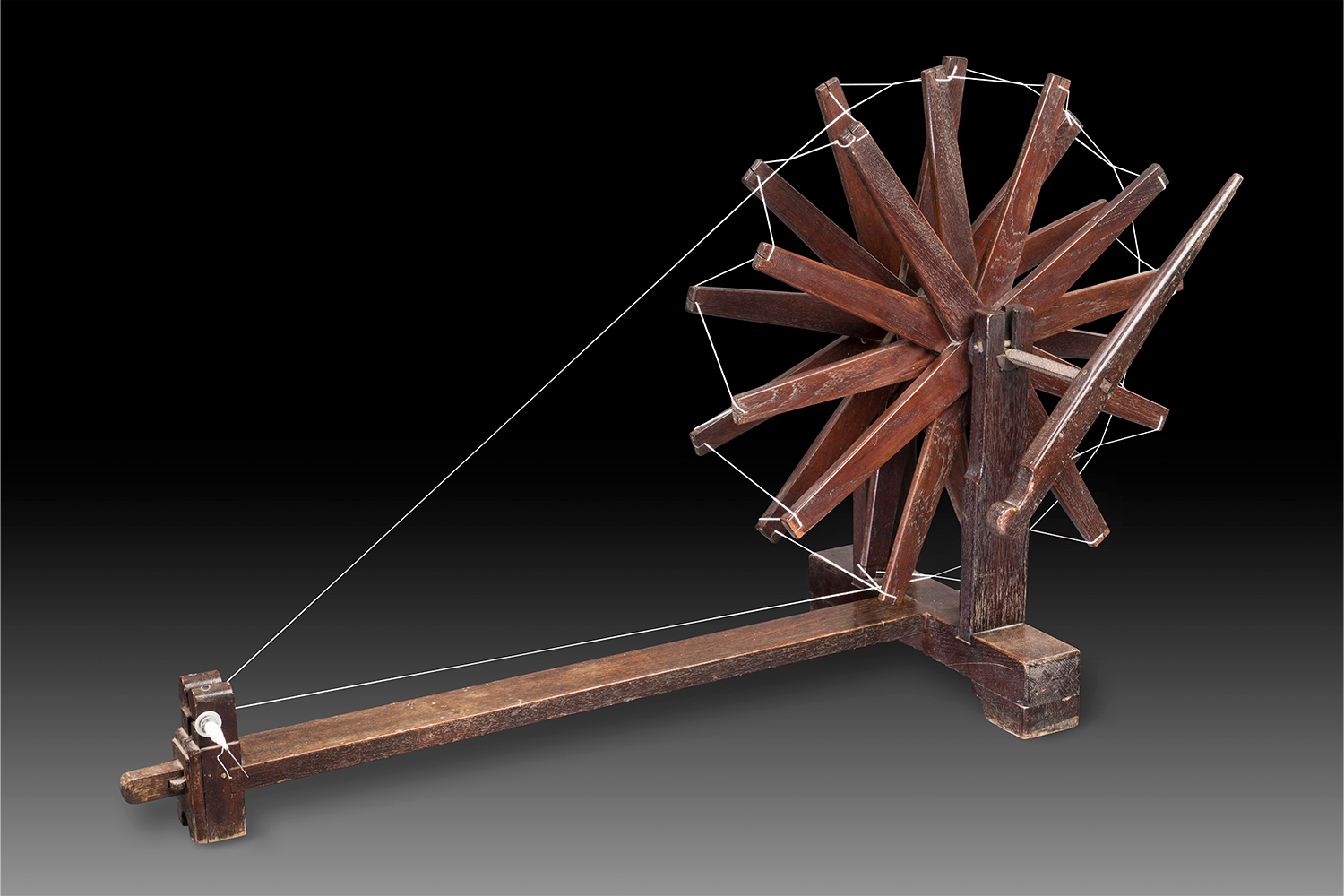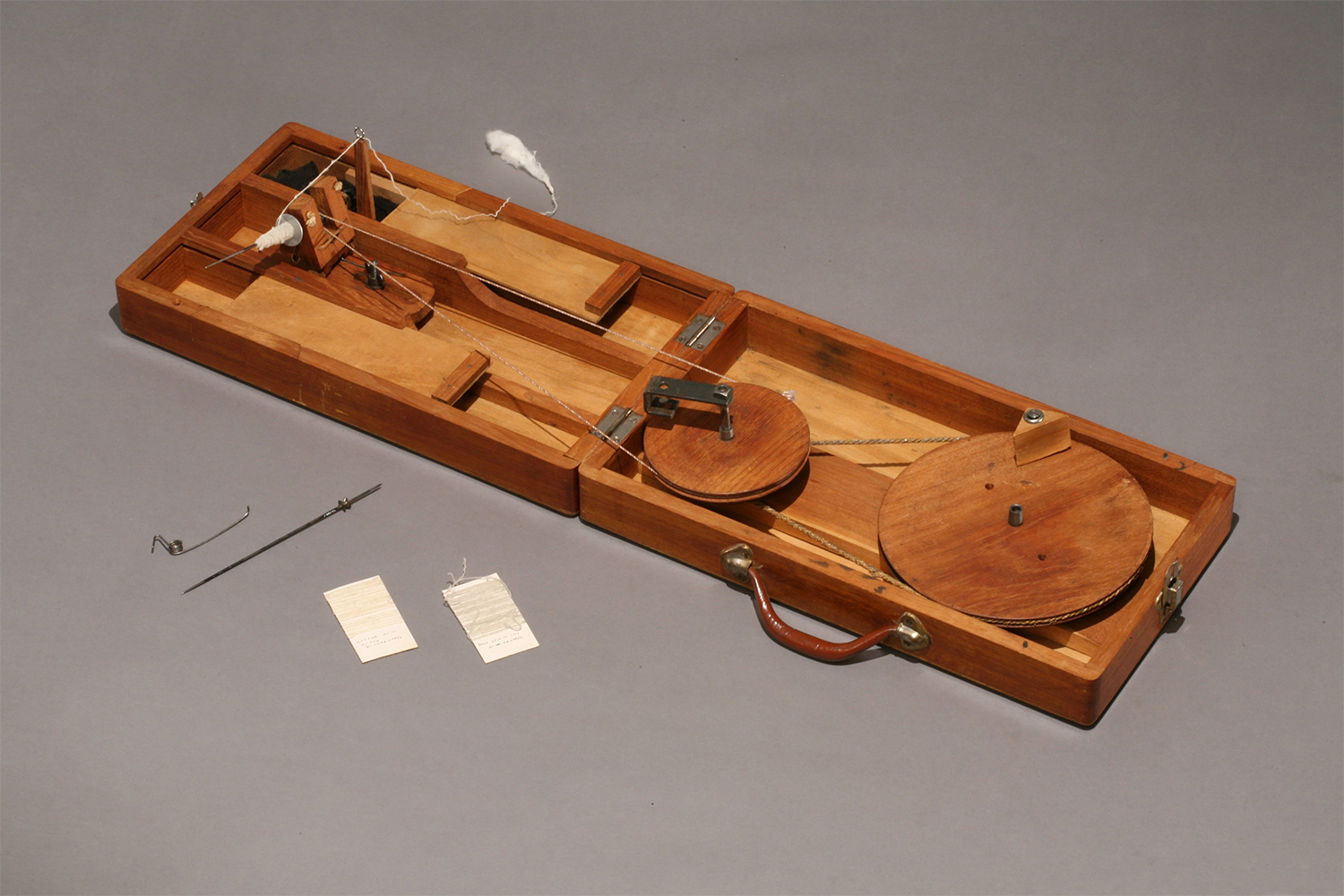ARTICLE
Charkha
Deriving its name from charkh, a Persian word meaning ‘wheel’ or ‘circle’, the charkha is a hand-driven spinning wheel used for spinning fibre into yarn, which can later be woven into fabric. It was designed to mechanise the earlier, slower method of hand-twisting fibre onto a spindle. Typically made of wood and used for small-scale, domestic production of yarn, the charkha became a prominent symbol of the Indian freedom struggle in the twentieth century. The charkha — and the more generic motif of the chakra, the flat spoked wheel with which it is often conflated — has historically been imbued with great symbolic significance in South Asia. In Buddhist iconography, the wheel of the law, or dharmachakra, represents the initiation of reformative and revolutionary actions, and features in the story of the Buddha’s first sermon.
With material evidence sparse for such perishable objects, the spinning wheel’s origin is a matter of speculation. Specimens of twisted cotton thread found from Indus Valley sites in the early twentieth century were initially used as evidence to date the charkha to the third millennium BCE. Contemporary scholars, however, consider this inconclusive as such a twist could also have been achieved with a handheld spindle instead. This, taken with the lack of specific visual representation of the spinning wheel in textile documents or literary sources before the thirteenth century, has been used to make the case that the spinning wheel may have been a medieval invention. The earliest known definitive appearance of the spinning wheel in the historical record is in an illustration appearing in al-Wasiti’s 1237 illuminated manuscript of the Maqamat-al-Hariri from present-day Iraq. A reference to the charkha in the Futuh-us-Salatin written in 1350 by Abdul Malik Isami is the earliest found in the Indian subcontinent. The word charkh, presumably used for spinning equipment, appears in Persian poetry from the twelfth and thirteenth centuries, and while it probably refers to the spinning wheel, this is difficult to establish conclusively. Meanwhile, a silk-reeling machine that appears in a tenth-century description is considered only vaguely similar to a charkha, and would not have been effective for other fibres such as cotton. This has led scholars to guess at a Persian origin for the spinning wheel, and propose that it spread from there to South Asia, Europe and China.
The most basic form of the charkha, the floor or table-top charkha, comprises an asymmetrical U-shaped wooden frame or pedestal, which holds a large spoked wheel on its higher arm and a horizontally mounted spindle on the other end, with a drive band connecting the two. The spindle is fed by a distaff, the rod onto which the raw carded (cleaned and combed) fibre has been gathered. The user of the charkha holds the distaff in one hand, at an appropriate distance and angle to the spindle, and turns the wheel with the other hand. The slow turning of the wheel spins the spindle fast enough to tightly twist and pull the fibre from the distaff to yield yarn, which is wound around the spindle. The driving wheel of the charkha is either a spoked wheel with a rim, or a rimless one with two or three layers of spokes. The speed of the spinning and the tautness of the yarn are entirely determined by the user, and the process is intermittent as the spun yarn must be periodically transferred onto a bobbin and new fibre introduced from the distaff.
A portable version, also known as the peti (‘box’) charkha, book charkha or Yerawada charkha, was developed by Mahatma Gandhi and his associates during his incarceration at Yerawada Jail in Poona (now Pune) in 1930–31. Essentially the same as the full-sized version, but incorporating an additional wheel, this charkha folds into a compact wooden case the size of a large book or small briefcase. Two wheels of different sizes connected by a drive band are fitted horizontally in one half of the case. The hand-driven larger wheel spins the smaller one, which is in turn connected by a drive band to the detachable spindle in the opposite half of the case.
The traditional full-sized spinning wheel — historically associated almost exclusively with women — was the basis of industrial machines such as the spinning jenny (1746) and the spinning mule (1779), which acted as catalysts for the Industrial Revolution in Britain. These new inventions, coupled with laws such as the Calico Acts, protected British textile manufacturers from the competition from Indian fabrics, until machine-made fabric was able to dominate the market in the nineteenth century. This industrialisation of British textile production was coordinated with its deindustrialisation in India. Following colonial expansion in the late eighteenth century, the British East India Company turned the subcontinent into a source of cheap raw materials such as unprocessed cotton to be spun and woven in Britain. The finished textiles were imported into India and sold to (typically middle- and upper-class) consumers, replacing hitherto domestically produced goods, and thereby impacting both the textile economy and fashion in the subcontinent.
The charkha became the symbol of the Swadeshi movement, started in 1905 and later brought into greater prominence by Gandhi. The movement called for the rejection of foreign-made goods, especially textiles, in favour of indigenous industries and self-reliance. The charkha represented the assertion of an Indian way of life and a counter to the mechanisation that led to the ruin of India’s textile industry. The charkha soon became closely associated with Gandhi himself, with his insistence on spinning cotton regularly as a patriotic as well as symbolic act. He also gifted a portable charkha to the American missionary Reverend Floyd A Puffer who was working for the poor in India at the time, after using it during one of his sentences at Yerawada Jail (1932–33). The historical artefact resurfaced decades later when it was placed on auction by British auction house Mullock’s in 2013 and 2014. However, due to a conflicting claim to the portable charkha by Puffer’s daughter, it was not sold despite securing bids well over the estimated range on both occasions.
Featuring frequently in imagery of the freedom struggle, in 1921 the charkha was adopted as the central emblem for the flag of the Provisional Government of Free India. Even though the symbol was later reduced to a single central wheel, representing the Ashokan chakra, the charkha remains associated with the Indian flag today. Modernist artists such as MF Husain and Jamini Roy have also used the nationalist symbol in their work, usually as a representation of rural life and the labour of traditional art forms.
Bibliography
Bibliography
Abraham, T. O. “US Missionary’s Indian Daughter Demands Gandhi’s Charkha Back.” Times of India, September 10, 2016. Accessed May 22, 2023. https://timesofindia.indiatimes.com/city/nagpur/us-missionarys-indian-daughter-demands-gandhis-charkha-back/articleshow/54257993.cms.
Museum of Design Excellence. “Charkha, the Device that Charged India’s Freedom Movement.” Google Arts & Culture. Accessed May 8, 2023. https://artsandculture.google.com/story/charkha-the-device-that-charged-india-s-freedom-movement-mode/BAUBNSJPyMyVJg?hl=en.
Habib, Irfan. “Pursuing the History of Indian Technology: Pre-Modern Modes of Transmission of Power.” Social Scientist 20, no. 3/4 (1992): 1–22. https://doi.org/10.2307/3517685.
Pacey, Arnold. Technology in World Civilization: A Thousand-Year History. Cambridge, MA: The MIT Press, 1991. 23–25. https://archive.org/details/technologyinworl0000pace/page/22/mode/2up.
“Spinning Wheel.” Britannica. Accessed May 8, 2023. https://www.britannica.com/technology/spinning-wheel.
“March of the Charkha.” The Voice of Fashion. October 2, 2019. Accessed May 8, 2023. https://thevoiceoffashion.com/fabric-of-india/crafts-and-textiles/march-of-the-charkha–3183.
National Gallery of Modern Art. “Explore the Life and Work of Pioneering Artist Jamini Roy.” Virtual Tour. Accessed May 8, 2023. http://ngmaindia.gov.in/virtual-tour-of-modern-art-1.asp.




